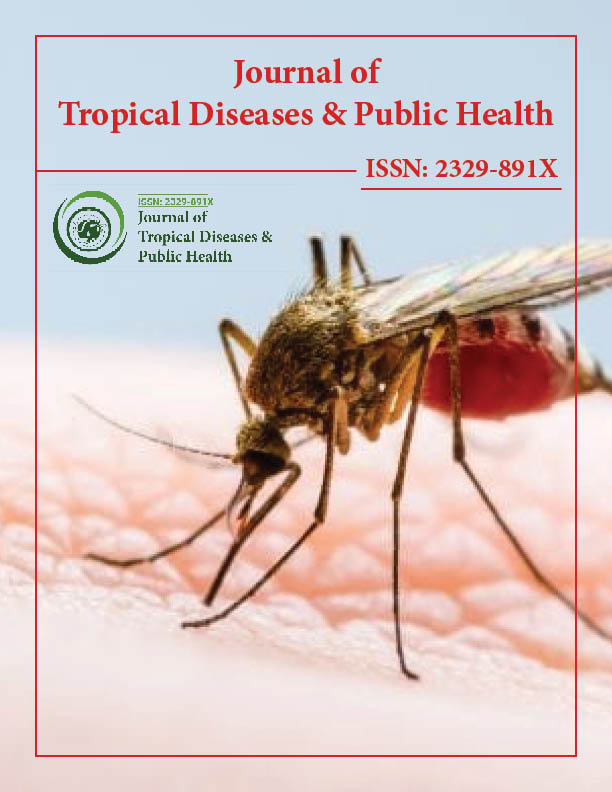Indexed In
- Open J Gate
- Academic Keys
- ResearchBible
- China National Knowledge Infrastructure (CNKI)
- Centre for Agriculture and Biosciences International (CABI)
- RefSeek
- Hamdard University
- EBSCO A-Z
- OCLC- WorldCat
- CABI full text
- Publons
- Geneva Foundation for Medical Education and Research
- Google Scholar
Useful Links
Share This Page
Journal Flyer

Open Access Journals
- Agri and Aquaculture
- Biochemistry
- Bioinformatics & Systems Biology
- Business & Management
- Chemistry
- Clinical Sciences
- Engineering
- Food & Nutrition
- General Science
- Genetics & Molecular Biology
- Immunology & Microbiology
- Medical Sciences
- Neuroscience & Psychology
- Nursing & Health Care
- Pharmaceutical Sciences
Opinion Article - (2025) Volume 14, Issue 2
Challenges of Implementing Vaccination Programs for Yellow Fever in Remote Tropical Forest Communities
Mariana Costa*Received: 26-May-2025, Manuscript No. JTD-25-29792; Editor assigned: 28-May-2025, Pre QC No. JTD-25-29792 (PQ); Reviewed: 11-Jun-2025, QC No. JTD-25-29792; Revised: 18-Jun-2025, Manuscript No. JTD-25-29792 (R); Published: 25-Jun-2025, DOI: 10.35241/2329-891X.25.13.475
Description
Yellow fever continues to pose a significant health challenge in remote tropical forest regions where access to healthcare services is limited and traditional lifestyles prevail. Vaccination remains the most effective method to prevent outbreaks and protect vulnerable populations, yet logistical difficulties and sociocultural factors often undermine immunization efforts. Exploring the complexities of delivering vaccines in these isolated communities highlights the multifaceted obstacles that hinder disease control.
Geographically, tropical forest communities are often located far from urban centers, requiring travel by boat, foot, or unpaved roads that may be impassable during rainy seasons. The physical isolation leads to irregular supply chains for vaccines, which demand careful temperature control to maintain efficacy. Maintaining cold chains under these conditions is a formidable challenge; power outages, long transit times, and limited refrigeration capacity threaten vaccine integrity. In some cases, vaccines arrive spoiled or expire before use, necessitating costly replacements and delaying immunization schedules.
The dispersed settlement patterns and small population clusters also complicate planning. Unlike urban settings where mass campaigns can reach thousands at once, health workers must visit multiple villages, often with few residents, to achieve adequate coverage. The travel and time involved increase operational costs and strain limited personnel resources. In addition, outreach workers face safety concerns related to wildlife, weather, and the physical demands of the environment.
Cultural beliefs and traditional practices influence vaccine acceptance. Many communities maintain a deep connection with ancestral ways and exhibit skepticism toward biomedical interventions introduced by external agencies. Misunderstandings about vaccine safety, fears of adverse effects, and rumors can quickly spread and reduce participation. In some cases, may discourage vaccination, viewing it as interference with natural or divine processes. Building trust requires sustained engagement, respect for local customs, and involvement of community leaders in educational efforts.
Communication barriers present further obstacles. Indigenous languages or dialects often differ significantly from national languages used in health campaigns. Health messages translated without cultural sensitivity may fail to resonate or even cause confusion. Limited literacy levels also reduce the effectiveness of written materials, making oral communication, storytelling, and visual aids critical tools. Yet, training health workers to deliver culturally appropriate messaging demands additional time and resources.
Healthcare infrastructure in tropical forest areas is typically minimal. Clinics, if present, often lack basic amenities, refrigeration, and trained staff for immunization services. Many rely on visiting teams that schedule campaigns infrequently, resulting in missed opportunities for vaccination, especially among mobile populations such as hunters, gatherers, or seasonal workers. These groups may be absent during campaigns and harder to locate for follow-up doses, if required.
Conclusion
In conclusion, delivering yellow fever vaccines to tropical forest inhabitants requires a comprehensive approach addressing geographic isolation, cultural contexts, infrastructure limitations, and environmental factors. Investments in cold chain technology, community engagement, multilingual education, and mobile healthcare teams are critical components. Strengthening local capacity and fostering collaboration between stakeholders can improve the reach and effectiveness of vaccination campaigns, contributing to the broader goal of yellow fever control in tropical regions.
Citation: Costa M (2025). Challenges of Implementing Vaccination Programs for Yellow Fever in Remote Tropical Forest Communities. J Trop Dis. 13:475.
Copyright: © 2025 Costa M. This is an open-access article distributed under the terms of the Creative Commons Attribution License, which permits unrestricted use, distribution and reproduction in any medium, provided the original author and source are credited.

